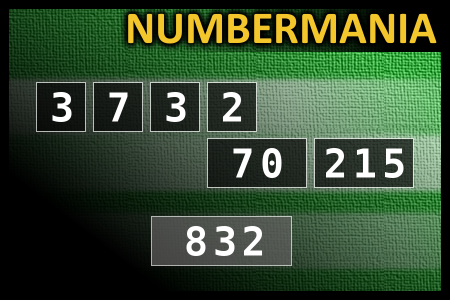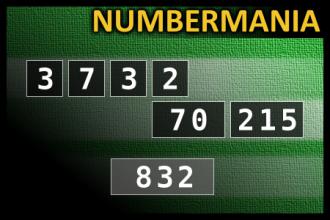Calculate the number 832
NUMBERMANIA: Calculate the number 832 using numbers [3, 7, 3, 2, 70, 215] and basic arithmetic operations (+, -, *, /). Each of the numbers can be used only once.Correct answers: 34
The first user who solved this task is Sanja Šabović.
#brainteasers #math #numbermania

The medics rushed Mr. Steinber...
The medics rushed Mr. Steinberg to the hospital in the middle of the night, apparently with a massive heart attack. The doctors work on him all night and morning and finally discharge him to Intensive Care Unit, where therapy continues.
After a couple of days, Mr. Steinberg's physician comes into his room and says, "Sol, I'm happy to tell you that you are completely well. You have the heart function that you did when you were a fifteen-year-old lad. We're going to send you home tomorrow. You don't have to worry about your heart; do any physical exercise that you like."
Mr. Steinberg goes home and that evening is talking with his wife. "Doris, you'll never believe it! I'm completely well. I have no worries with my heart. Tonight, Darling, you and I are going to make love like you've never had before - wild, passionate sex! You'll love it!"
Doris thinks for a minute and says, "I don't know, Sol. I've heard about active sex and heart conditions. I don't want it to be on my conscience if you die while we are making love. Maybe, just maybe, if your doctor wrote a note to me saying that everything was okay, maybe I would have such sex with you."
Mr. Steinberg was dejected, but the next day he was in his doctor's office. His doctor tells him, "Sure, sure, Sol, no problem, I'll write the note. Let's see, here's my prescription pad: 'Mr. Sol Steinberg, a patient of mine, has the heart function of a fifteen-year-old lad, and can have mad, passionate, adventurous sex any time that he so desires, signed, Dr. Aaron Katz.' Now, I'll just address this. By the way, Sol, what's your wife's first name?"
"Uh, Doctor, could you just make that, 'To Whom It May Concern'?"
After a couple of days, Mr. Steinberg's physician comes into his room and says, "Sol, I'm happy to tell you that you are completely well. You have the heart function that you did when you were a fifteen-year-old lad. We're going to send you home tomorrow. You don't have to worry about your heart; do any physical exercise that you like."
Mr. Steinberg goes home and that evening is talking with his wife. "Doris, you'll never believe it! I'm completely well. I have no worries with my heart. Tonight, Darling, you and I are going to make love like you've never had before - wild, passionate sex! You'll love it!"
Doris thinks for a minute and says, "I don't know, Sol. I've heard about active sex and heart conditions. I don't want it to be on my conscience if you die while we are making love. Maybe, just maybe, if your doctor wrote a note to me saying that everything was okay, maybe I would have such sex with you."
Mr. Steinberg was dejected, but the next day he was in his doctor's office. His doctor tells him, "Sure, sure, Sol, no problem, I'll write the note. Let's see, here's my prescription pad: 'Mr. Sol Steinberg, a patient of mine, has the heart function of a fifteen-year-old lad, and can have mad, passionate, adventurous sex any time that he so desires, signed, Dr. Aaron Katz.' Now, I'll just address this. By the way, Sol, what's your wife's first name?"
"Uh, Doctor, could you just make that, 'To Whom It May Concern'?"

